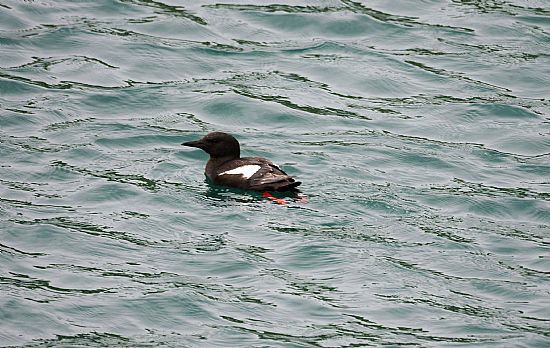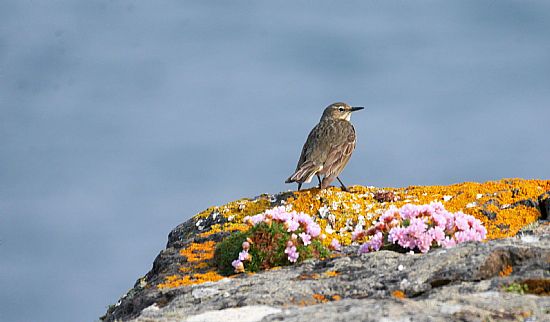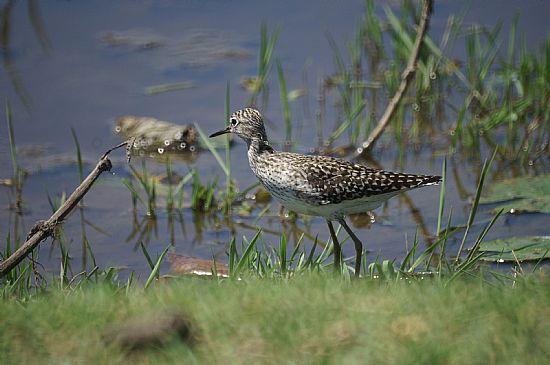Scottish Highlands, May 2025
Mark Finn
May 4-11
May 4th: Strathpeffer, Udale Bay, Cromarty Firth
Daily 44 New 44 Running 44
Weather: Cloudy with a NE wind 9c
Due to the late arrival of clients into Inverness airport I arranged a short late afternoons birding to Strathpeffer and the Cromarty Firth. The highlight at Strathpeffer was close views of Horned Grebes in their resplendent summer dress. Also present on the loch were Little Grebe, Tufted Duck, Herring and Common Gulls and Common Coot. In the surrounding trees we located Blackcap, Willow Warbler, European Goldfinch and Common Chaffinch. Udale Bay was next on the agenda where we located Common Shelduck, Eurasian Curlew, Common Redshank, Grey Heron, Pied and White Wagtails, Tree and Meadow Pipits. Beyond the village of Jemimaville a scan of the firth added sizeable groups of Greater Scaup, Long-tailed Duck, Common Eider and several pairs of Red-throated Divers.
Mammals: Roe Deer (2), Brown Hare (1)
May 5th: Orrin, Achanalt, Achnasheen, Kinlochewe, Gairloch, Loch Ewe, Laide, Gruinard Bay
Daily 75 New 41 Running 85
Weather: Sunny with SW winds 14c
Birds in the garden included Blackcap, Common Whitethroat and Reed Bunting. The first birding stop was the silver birch woods at Orrin which gave us good sightings of Wood and Willow Warblers and Song Thrush. Achanalt really needs a protected status as it is excellent for several scarce birds of the Highlands. A careful scan revealed Common and Wood Sandpipers, Canada Goose, Eurasian Teal, Eurasian Wigeon and Tufted Duck. The loch near Achnasheen held Common Greenshank, Common Snipe and Common Cuckoo. A short stop at Kinlochewe gardens produced the Hebridean form of Dunnock, Collared Dove and Pied Wagtail. Our journey took us through the spectacular landscapes of Wester Ross and onto the remote village of Gairloch. Viewing into the Loch Gairloch was good for Red-throated and Black-throated Divers, Red-breasted Merganser, Northern Gannet, Arctic Terns and several gull species. I made a diversion towards the end of the road where two Northern Wheatears of the Greenland race were located by the cliffs. Loch Ewe was strangely quiet today so I headed to Laide where an adult White-tailed Eagle flew above our heads. Offshore there was a notable upturn in Great Northern Diver numbers before we ended the day looking at Gruinard Island without any return.
Mammals: Red Deer (5), Brown Hare (4)

Black Guillemot
May 6th: Corrimony, Novar Estate, Portmahomack, Embo, The Mound, Brora, West Langwell
Daily 74 New 16 Running 101
Weather: Sunny with SE winds -1c/15c
Our day started with a visit to Corrimony an area of moors, woodland and hills. Before we arrived a Eurasian Woodcock was seen on the road before flying into cover. It was time to pick up Alex the warden and visit the first of three leks for Black Grouse all of which were busy with displaying birds doing their stuff to attract females (a total of 31 individuals seen). Also present in the area were Common Greenshank, Mistle and Song Thrushes and Northern Wheatear. Breakfast was taken in Alness followed by a visit to the Novar Estate with sightings of Goldcrest, Great and Coal Tits and Common Chaffinch, no sign of crossbills on this visit which is unusual. Portmahomack was the next stop where we scanned the bay with observations of Red-throated Diver, Long-tailed Duck, Common Scoter, Red-breasted Merganser, Common Eider, Osprey and in the fields Common Linnet. The tide at Embo was high which was to our advantage with a party of Purple Sandpipers showing on exposed rocks with Ruddy Turnstone and Bar-tailed Godwits. The Mound and Brora held the regular Osprey, Common Sandpiper, Common Shelduck, Black Guillemot and Great Spotted Woodpecker. A drive towards West Langwell did not anything new apart from a pair of Whooper Swans at the far end.
Mammals: Brown Hare (6), Harbour Porpoise (1), Common Rabbit (c), North Atlantic Grey Seal (c)

European Rock Pipit
May 7th: Glen Loth, Barrobol, Forsinard, Sandside Bay, Scrabster, Dunnet Bay, St John’s Pool, Dunnet Head
Daily 84 New 13 Running 114
Weather: Sunny with a cool SE wind 14c
Today I headed north towards Caithness and Sutherland with a stop at Brora. A recheck here of species added a steady flow of Black-legged Kittiwakes offshore. Glen Loth was next on the agenda a remote road through mountainous country and forest habitats. One of the first birds seen was a male Hen Harrier hunting close to the road and nearby drumming and displaying Common Snipe. Northern Wheatears were fairly common whilst the remaining stands of trees attracted Common Chaffinch and European Greenfinch. At Borrobol a remote country estate a check of the gardens and adjacent bushes added Red Kite, Barn Swallow, Common Blackbird, Song Thrush and in the sheep fields Lesser Black-backed, European, Common and Black-headed Gulls. On the edge of Forsinard a large loch had attracted Common Scoters no doubt a part of the small breeding population of the area. These were joined by Black-throated Diver, a single Pink-footed Goose and further along the road a pair of Hen Harriers. At Forsinard stop beyond the research centre added a party of European Golden Plovers and Northern Lapwings. Our journey took us to the NC500 and Sandside Bay which is sheltered from the worst of the Pentland Firth weather. On arrival the bay held Red-throated and Great Northern Divers, Sandwich and Arctic Terns, Common Shelduck, European Shag, Ringed Plover, Dunlin, Whimbrel, Razorbill and Common Guillemot. A short stop at Scrabster Harbour allowed close views of Common Eider and Black Guillemot but no sign of any white-winged gulls so I pressed on to Dunnet Bay. The beach held an first year Glaucous Gull, Common Tern and a raft of Long-tailed Ducks offshore. St John’s Pool is close by and open today. From the hide close views of nesting Arctic, Common and Sandwich Terns, Northern Shoveler, Gadwall, Tufted Duck and Common Moorhen. Our last birding stop was the cliffs of Dunnet Head the most northerly point of mainland Britain. The group quickly located Atlantic Puffins among the commoner auks, Northern Fulmar and European Rock Pipits nesting in the lighthouse walls. I returned to Thurso where we stayed for the night.
Mammals: Red Deer (3), NA Grey Seal (c), Common Rabbit (c)

Wood Sandpiper
May 8th: Bettyhill, Hope Valley, Balnakeil, Scourie, Ullapool
Daily 69 New 2 Running 116
Weather: Sunny with brisk NW winds 21c
The first surprise of the day was three Common Swifts flying around the centre of Thurso, not normally here so must be overshoot migrants and the only sighting of this species during the week. We were soon on the road to the village of Bettyhill and its picturesque beaches and sheep fields. The usual species were around the area including a few Northern Wheatears and Common Mergansers in the river system. On the way towards the Hope Valley a Red Grouse showed briefly by the roadside. The road down the valley runs through silver birch woodland and Loch Hope but today it produced little of interest apart from Northern Ravens. The road towards Durness was slow due to many campervans and tourist traffic running around Loch Eriboll. At Durness we diverted to Balnakeil Bay and the bay of the same name. In the bay and adjacent fields we located Great Northern Diver, Common Guillemot, Razorbill, Whimbrel and Common Linnet. Our main interest was slightly inland at the old water meadows and fields which are a magnet for birdlife. Careful scanning revealed the presence of Whooper and Mute Swans, Pink-footed and Greylag Geese, Little Grebe, Wood Sandpiper, and various duck species. The journey south via Scourie and Ullapool added another White-tailed Eagle, Red-throated Divers and a pair of Common Sandpipers.
Mammals: Red Deer (c), Common Rabbit (c)
May 9th: Cairngorm, Loch Morlich, Loch an Eilean, Loch Garten, Nethybridge
Daily 53 New 7 Running 123
Weather: Sunny with light SW winds 23c
Weather conditions today were ideal for visiting Cairngorm with blue skies and almost no wind. On the way a visit to Loch Morlich was productive for Common Kestrel, Common Goldeneye and Mallard. The railway was on time as we recorded several Ring Ouzels before reaching the terminus and a single Red Grouse. At the top a slow walk towards the summit proved to be successful with sightings of Rock Ptarmigan, Eurasian Dotterel and Snow Buntings around the highest cairn. This took most of the morning as we dropped into Loch an Eilean for lunch and a short walk afterwards. Nothing to report here apart from the numerous woodland species and Loch Garten was similar. At the latter brief views of Crested Tit a hard bird to find in May. At the end of the day Nethybridge had Common Mergansers and a Osprey fishing along the river. A productive day for observing the mountain birds of the Highlands.
Mammals: Red Deer (c), Common Rabbit (c)
May 10th: Alturlie, Nairn, Roseisle, Burghead, Lossiemouth, Loch Spynie, Dava Moor, Grantown, Cromdale
Daily 69 New 4 Running 123
Weather: Sunny with SW winds 24c
Today was to be the hottest day of the year so far which affected the birding along the Moray coast. I started with a visit to Alturlie where a garden held a Eurasian Magpie a rare bird in the Highlands. A walk along the track produced sightings of Common Whitethroat, Sedge Warbler and Yellowhammer. Hirundines were common on wires and hawking for insects over a pond. In the marsh the group found Common Snipe and Eurasian Teal. Our journey took us to Nairn and the pier. A scan of the Moray Firth added Red-throated Diver, Razorbill and Common Guillemot and two Grey Wagtails on the upper reaches of the River Nairn. It was time to head towards Roseisle via a section of Findhorn Bay which still held Pink-footed Geese and a pair of Grey Partridges. Roseisle was busy with folk in the forest and along the beach so I moved on to Burghead and Lossiemouth. Not much to report with disturbance a major problem today. Lunch was taken at Loch Spynie followed by a walk down to the new hide. From the hide recently arrived Common Terns, Common Goldeneye, Gadwall and the common ducks. By the car park plenty of Tree Sparrows and singing Willow Warblers and Common Chiffchaffs. From here I went directly to Dava Moor where we quickly located the scarce and declining Red Grouse with three young. Visits to Grantown and finally Cromdale were very quiet apart from a White-throated Dipper feeding on the latter under a bridge.
Mammals: Common Rabbit (c)
May 11th: Cygnus House, Findhorn Valley, Inverness Airport
Daily n/r New 4 Final 127
Weather: Sunny with SW winds 18c
Due to afternoon flight times I was able to visit the Findhorn Valley in the morning. The usual birds were at Cygnus House so I headed straight to the valley. Our first stop was opposite a field favoured by birds and we quickly located Northern Lapwing, European Golden Plover, Eurasian Curlew, Eurasian Oystercatchers and large groups of Common Woodpigeons. On a ridge several Red Kites were joined by a hunting Peregrine Falcon and Common Buzzards. At the end of the public road we waited for birds and were rewarded by the song of a Ring Ouzel, Song and Mistle Thrushes, Pied Wagtail, Meadow Pipit and House Martin with the latter nesting on cliffs. We had run out of time and slowly retraced our steps to the A9 and back to the airport where the tour concluded.

